Performance Assessment of Two Different Phase Change Materials for Thermal Energy Storage in Building Envelopes
Abstract
:1. Introduction
1.1. Goal and Scope of the Study
1.2. Literature Review of PCM Numerical Modeling
1.3. Thermal Energy Storage
1.4. Phase Change Materials
2. Materials and Methods
2.1. Materials
2.2. PASLINK-Type Testing
2.3. Experimental Setup
2.4. Planning of the Experiment
- -
- The experiment begins with the outdoor temperature as the initial state. Both the solar wall module setups and the climate chamber are cooled to the same initial state before the start of the experiment.
- -
- During both the heating and cooling phases, the outdoor temperature is kept constant, set to the average temperature of a typical day in that season.
- -
- The duration of daylight and the intensity of solar radiation are also taken into consideration.
2.5. Numerical Modeling of the System
- -
- Melting is a two-dimensional transient phenomenon.
- -
- The movement of the PCM in its liquid state is turbulent, non-Newtonian, and incompressible.
- -
- Viscosity, density, and thermal conductivity are constant.
- -
- Heat generation, volume expansion, and viscous heating are not considered.
3. Results
3.1. Steady-State Experiment
3.2. Dynamic Experiment
3.3. Numerical Simulation
4. Discussion and Conclusions
Author Contributions
Funding
Data Availability Statement
Conflicts of Interest
References
- European Commission. The European Green Deal; European Commission: Brussels, Belgium, 2019. [Google Scholar]
- European Union. Directive (EU) 2018/844 of the European Parliament and of the Council of 30 May 2018 amending Directive 2010/31/EU on the energy performance of buildings and Directive 2012/27/EU on energy efficiency. Off. J. Eur. Union 2018, L156, 75. [Google Scholar]
- EU. Directive (EU) 2018/2001 of the European Parliament and of the Council on the promotion of the use of energy from renewable sources. Off. J. Eur. Union 2018, L328, 82–209. [Google Scholar]
- Ahangari, M.; Maerefat, M. An innovative PCM system for thermal comfort improvement and energy demand reduction in building under different climate conditions. Sustain. Cities Soc. 2019, 44, 120–129. [Google Scholar] [CrossRef]
- Saffari, M.; Roe, C.; Finn, D.P. Improving the building energy flexibility using PCM-enhanced envelopes. Appl. Therm. Eng. 2022, 217, 119092. [Google Scholar] [CrossRef]
- Alshuraiaan, B. Efficient Utilization of Pcm in Building Envelope in a Hot Environment Condition. SSRN Electron. J. 2022, 16, 100205. [Google Scholar] [CrossRef]
- Arumugam, P.; Ramalingam, V.; Vellaichamy, P. Effective PCM, insulation, natural and/or night ventilation techniques to enhance the thermal performance of buildings located in various climates—A review. Energy Build. 2022, 258, 111840. [Google Scholar] [CrossRef]
- Al-Saadi, S.N.; Zhai, Z. Modeling phase change materials embedded in building enclosure: A review. Renew. Sustain. Energy Rev. 2013, 21, 659–673. [Google Scholar] [CrossRef]
- Ručevskis, S.; Akishin, P.; Korjakins, A. Performance Evaluation of an Active PCM Thermal Energy Storage System for Space Cooling in Residential Buildings. Environ. Clim. Technol. 2019, 23, 74–89. [Google Scholar] [CrossRef] [Green Version]
- Yassi, M.E.; Abbassi, I.E.; Pierre, A.; Melinge, Y. Comparative Study of Two Materials Combining a Standard Building Material with a PCM. Fluid Dyn. Mater. Process. 2023, 19, 1283–1290. [Google Scholar] [CrossRef]
- Rehman, A.U.; Sheikh, S.R.; Kausar, Z.; Mccormack, S.J. Numerical Simulation of a Novel Dual Layered Phase Change Material Brick Wall for Human Comfort in Hot and Cold Climatic Conditions. Energies 2021, 14, 4032. [Google Scholar] [CrossRef]
- Rucevskis, S.; Akishin, P.; Korjakins, A. Parametric analysis and design optimisation of PCM thermal energy storage system for space cooling of buildings. Energy Build. 2020, 224, 110288. [Google Scholar] [CrossRef]
- Selvaraju, A.P.; Ranganathan, A.; Vincent, A.A.R.; Arumugam, P.; Ramalingam, V. Thermal management analysis of PCM integration in building using a novel performance parameter PCM effectiveness Index. Therm. Sci. 2022, 26, 883–895. [Google Scholar] [CrossRef]
- Teja, P.N.S.; Gugulothu, S.K.; Sastry, G.R.; Burra, B.; Bhurat, S.S. Numerical analysis of nanomaterial-based sustainable latent heat thermal energy storage system by improving thermal characteristics of phase change material. Environ. Sci. Pollut. Res. 2022, 29, 50937–50950. [Google Scholar] [CrossRef] [PubMed]
- Liang, D.M.; Ibrahim, M.; Saeed, T.; El-Refaey, A.M.; Li, Z.X.; Fagiry, M.A. Simulation of a Trombe wall with a number of semicircular fins placed on the absorber plate for heating a room in the presence of nano-PCM. J. Build. Eng. 2022, 50, 104173. [Google Scholar] [CrossRef]
- Su, W.G.; Darkwa, J.; Kokogiannakis, G. Numerical thermal evaluation of laminated binary microencapsulated phase change material drywall systems. Build. Simul. 2020, 13, 89–98. [Google Scholar] [CrossRef]
- Al-Mudhafar, A.H.N.; Hamzah, M.T.; Tarish, A.L. Potential of integrating PCMs in residential building envelope to reduce cooling energy consumption. Case Stud. Therm. Eng. 2021, 27, 101360. [Google Scholar] [CrossRef]
- Sarbu, I.; Sebarchievici, C. A comprehensive review of thermal energy storage. Sustainability 2018, 10, 191. [Google Scholar] [CrossRef] [Green Version]
- Allison, T.; Smith, N.R.; Ma, Z. Chapter 1—Introduction to energy storage. In Thermal, Mechanical, and Hybrid Chemical Energy Storage Systems; Brun, K., Allison, T., Dennis, R.B.T., Eds.; Academic Press: Cambridge, MA, USA, 2021; pp. 1–25. ISBN 978-0-12-819892-6. Available online: https://www.sciencedirect.com/science/article/pii/B9780128198926000010 (accessed on 12 February 2023).
- Ahmed, N.; Elfeky, K.E.; Lu, L.; Wang, Q.W. Thermal and economic evaluation of thermocline combined sensible-latent heat thermal energy storage system for medium temperature applications. Energy Convers. Manag. 2019, 189, 14–23. [Google Scholar] [CrossRef]
- IRENA. Innovation Outlook Thermal Energy Storage; IRENA: Masdar City, United Arab Emirates, 2020. [Google Scholar]
- Al-Yasiri, Q.; Szabó, M. Paraffin as a Phase Change Material to Improve Building Performance: An Overview of Applications and Thermal Conductivity Enhancement Techniques. Renew. Energy Environ. Sustain. 2021, 6, 38. [Google Scholar] [CrossRef]
- Ansu, A.K.; Sharma, R.K.; Tyagi, V.V.; Sari, A.; Ganesan, P.; Tripathi, D. A cycling study for reliability, chemical stability and thermal durability of polyethylene glycols of molecular weight 2000 and 10,000 as organic latent heat thermal energy storage materials. Int. J. Energy Res. 2020, 44, 2183–2195. [Google Scholar] [CrossRef]
- Duttaluru, G.; Singh, P.; Kumar, A. Methods to enhance the thermal properties of organic phase change materials: A review. Mater. Today Proc. 2022, 63, 685–691. [Google Scholar] [CrossRef]
- Heier, J.; Bales, C.; Martin, V. Combining thermal energy storage with buildings—A review. Renew. Sustain. Energy Rev. 2015, 42, 1305–1325. [Google Scholar] [CrossRef]
- Soibam, J. Numerical Investigation of a Heat Exchanger Using Phase Change Materials (PCMs). Master’s Thesis, Mälardalen University, Västerås, Sweden, 2017. [Google Scholar]
- Ben Romdhane, S.; Amamou, A.; Ben Khalifa, R.; Saïd, N.M.; Younsi, Z.; Jemni, A. A review on thermal energy storage using phase change materials in passive building applications. J. Build. Eng. 2020, 32, 101563. [Google Scholar] [CrossRef]
- Lai, C.M.; Hokoi, S. Thermal performance of an aluminum honeycomb wallboard incorporating microencapsulated PCM. Energy Build. 2014, 73, 37–47. [Google Scholar] [CrossRef]
- Silva, T.; Vicente, R.; Soares, N.; Ferreira, V. Experimental testing and numerical modelling of masonry wall solution with PCM incorporation: A passive construction solution. Energy Build. 2012, 49, 235–245. [Google Scholar] [CrossRef]
- De Gracia, A.; Navarro, L.; Castell, A.; Ruiz-Pardo, Á.; Alvárez, S.; Cabeza, L.F. Experimental study of a ventilated facade with PCM during winter period. Energy Build. 2013, 58, 324–332. [Google Scholar] [CrossRef]
- Rubitherm. PCM RT-LINE. Available online: https://www.rubitherm.eu/en/productcategory/organische-pcm-rt (accessed on 20 April 2023).
- Norlén, U. Estimating thermal parameters of outdoor test cells. Build. Environ. 1990, 25, 17–24. [Google Scholar] [CrossRef]
- Madsen, H.; Holst, J. Estimation of continuous-time models for the heat dynamics of a building. Energy Build. 1995, 22, 67–79. [Google Scholar] [CrossRef]
- Wouters, P.; Vandaele, L.; Voit, P.; Fisch, N. The use of outdoor test cells for thermal and solar building research within the PASSYS project. Build. Environ. 1993, 28, 107–113. [Google Scholar] [CrossRef]
- Guo, J.; Zhang, G. Investigating the performance of the PCM-integrated building envelope on a seasonal basis. J. Taiwan Inst. Chem. Eng. 2021, 124, 91–97. [Google Scholar] [CrossRef]
- Wald, N.J.; Rodeck, C.; Hackshaw, A.K.; Walters, J.; Chitty, L.; Mackinson, A.M. Solar Energy Perspectives: Executive summary. J. Med. Screen. 2003, 10, 56–57. [Google Scholar] [CrossRef] [Green Version]
- Cho, Y.; Kim, J.J. Lifetime decrease of halogen lamps for automotive by duty cycle stress. IEEE Trans. Reliab. 2011, 60, 550–556. [Google Scholar] [CrossRef]
- OTT Hydromet GMBH. Pyranometer CMP3|SMP3. Available online: https://www.otthydromet.com/en/p-kippzonen-smp3-pyranometer/0374900 (accessed on 12 February 2023).
- Thermocouple. Type K Thermocouple. Available online: https://www.thermocoupleinfo.com/type-k-thermocouple.htm (accessed on 12 February 2023).
- ANSYS. Knowledge Creation Diffusion Utilization. In ANSYS Fluent User’ s Guide; Release 13.0.; ANSYS, Inc.: Canonsburg, PA, USA, 2013; Volume 15317, pp. 724–746. [Google Scholar]
- Hassab, M.A.; Sorour, M.M.; Mansour, M.K.; Zaytoun, M.M. Effect of volume expansion on the melting process’s thermal behavior. Appl. Therm. Eng. 2017, 115, 350–362. [Google Scholar] [CrossRef]
- Vanaga, R.; Narbuts, J.; Freimanis, R.; Blumberga, A. Laboratory Testing of Different Melting Temperature Phase Change Materials Under Four Season Conditions for Thermal Energy Storage in Building Envelope. In Proceedings of the International Conference on Applied Energy, Virtual, 29 November–5 December 2021. [Google Scholar]

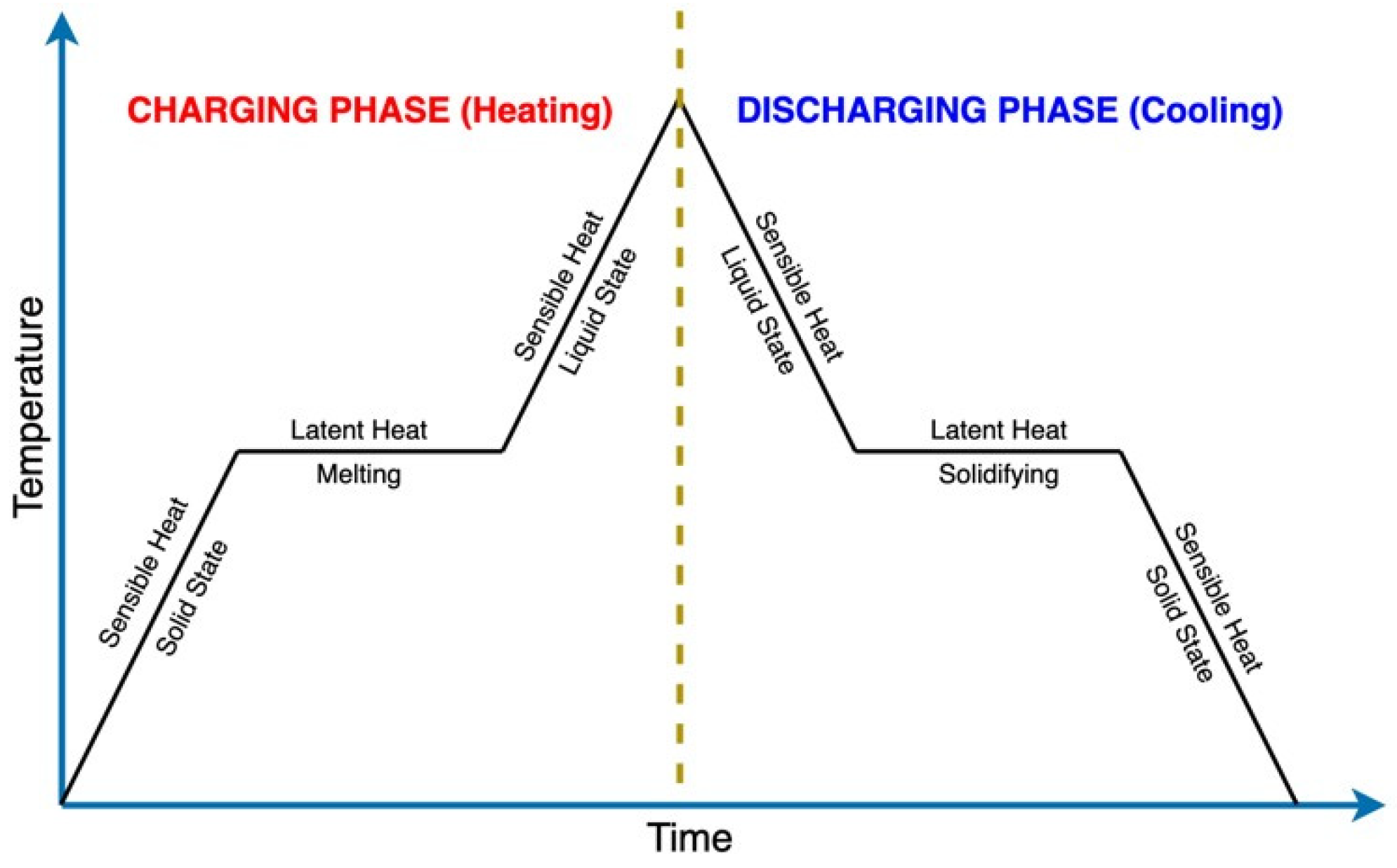

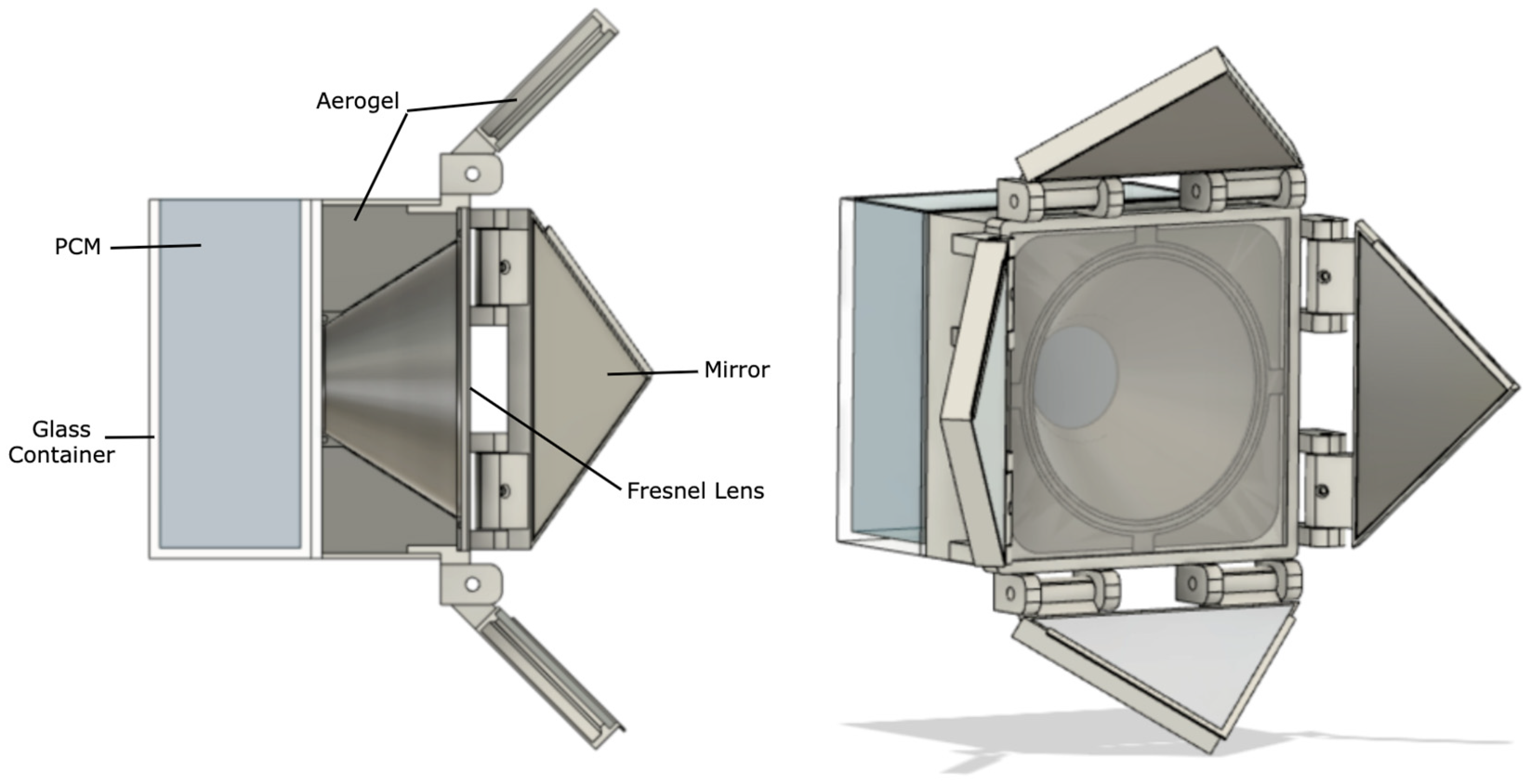


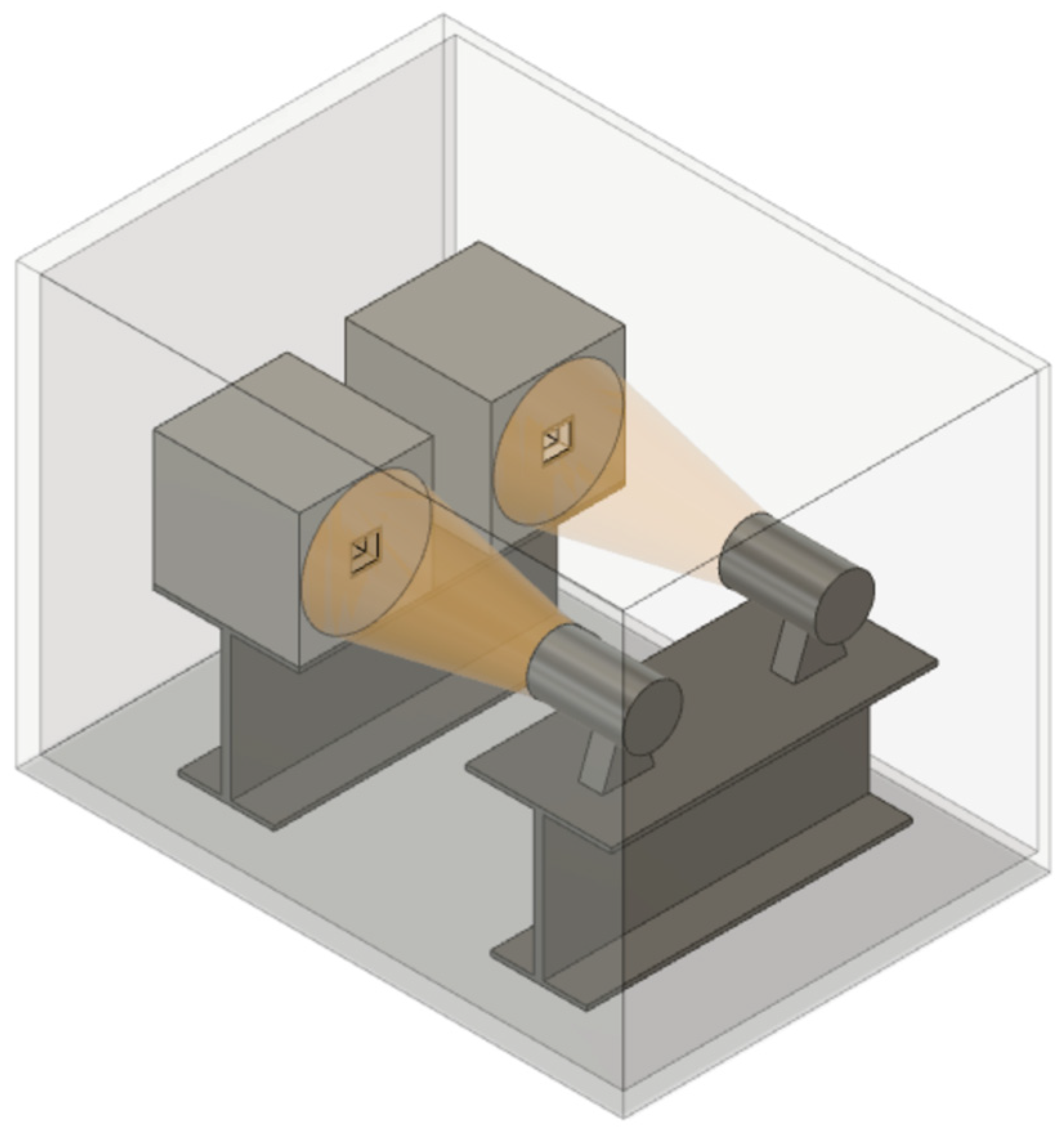
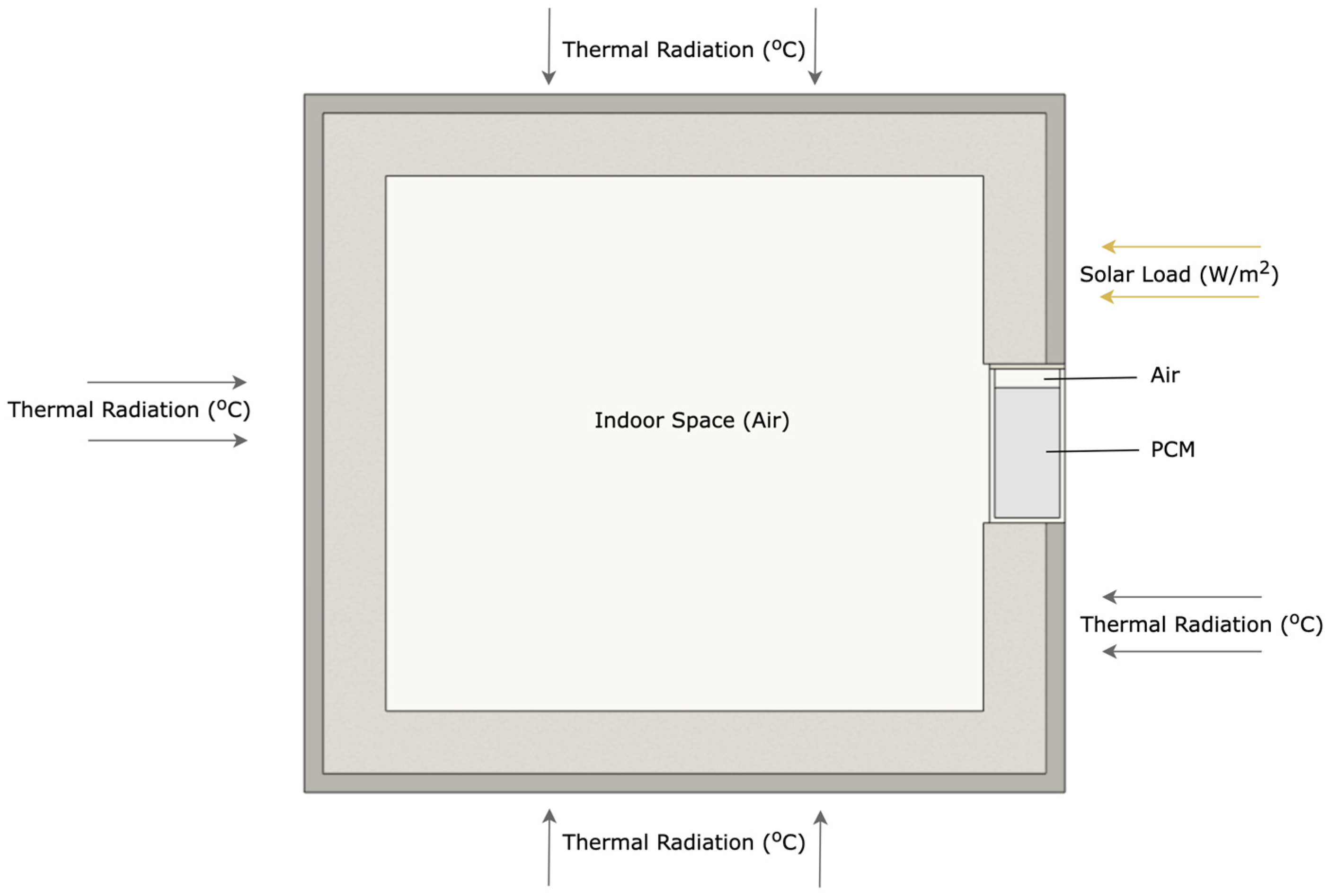



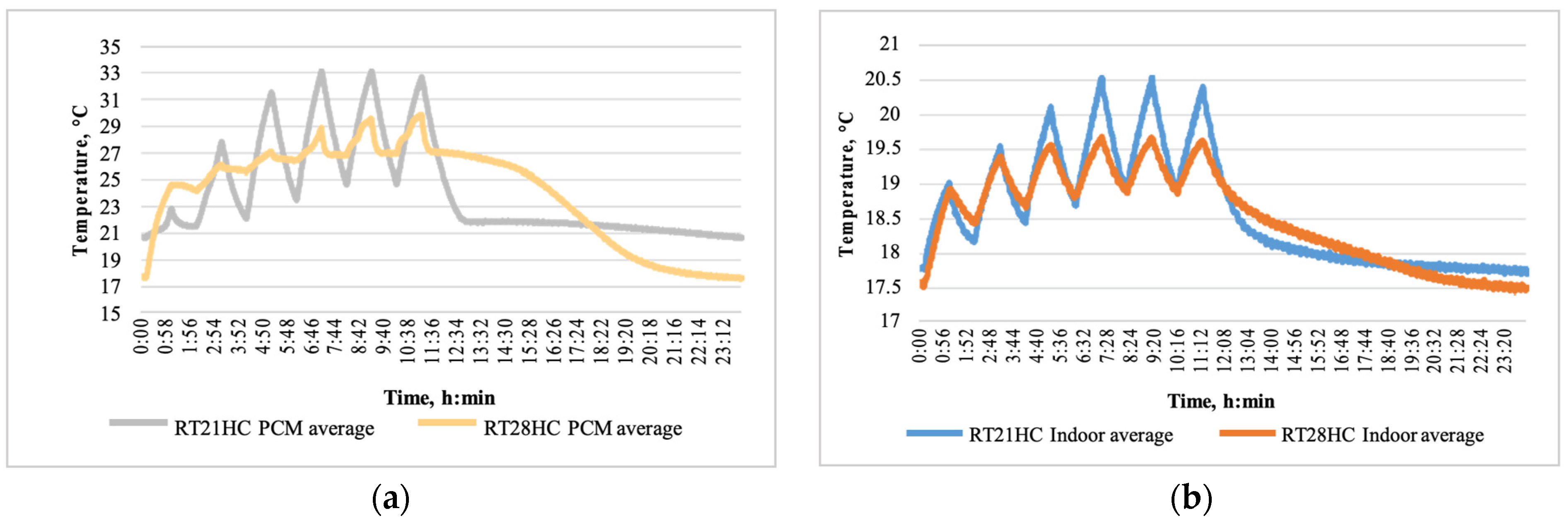



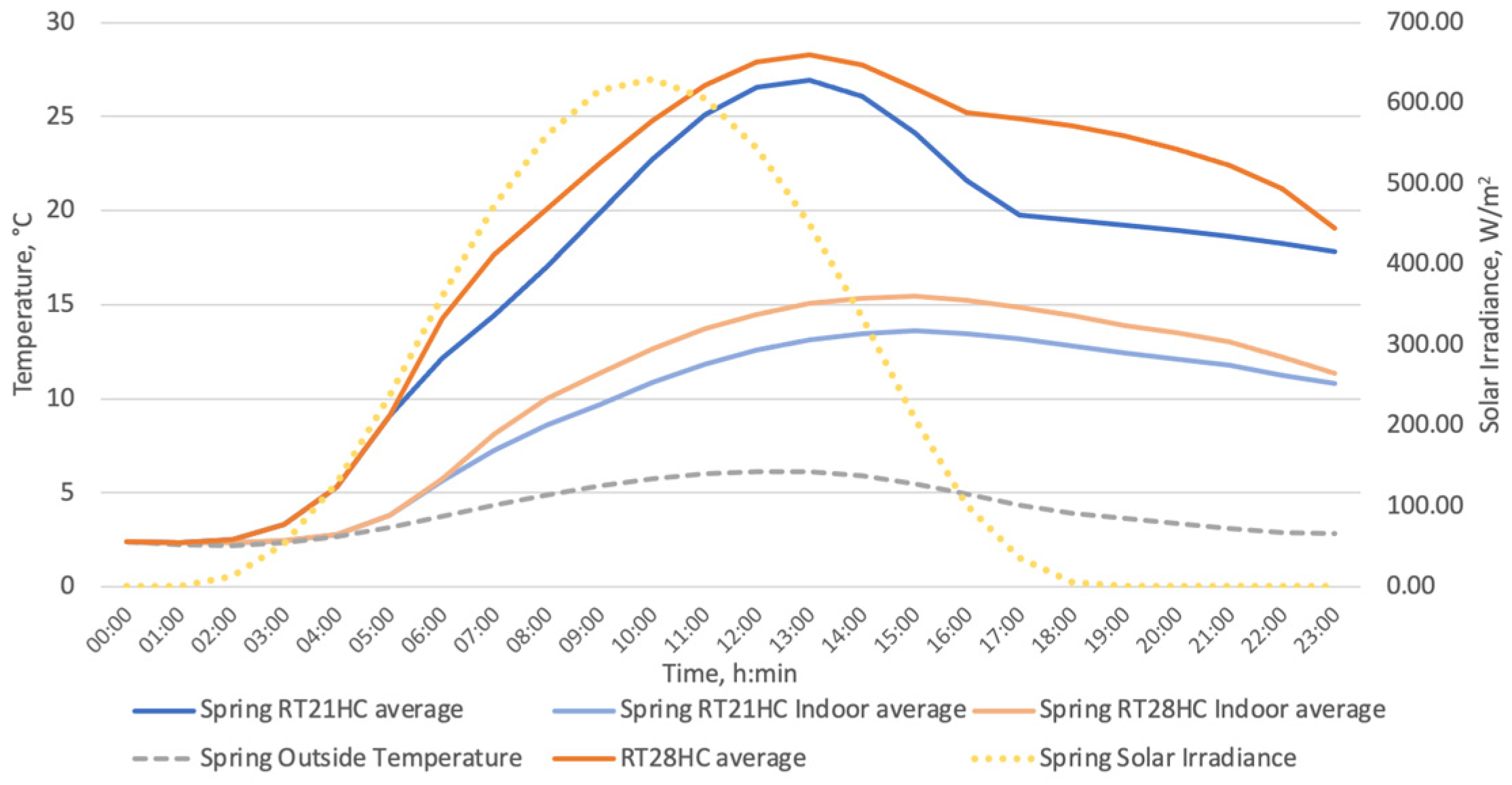





| Publication | Time Scale | Scale (Element, Room, or Building) | Building Envelope |
|---|---|---|---|
| Performance Evaluation of an Active PCM Thermal Energy Storage System for Space Cooling in Residential Buildings [9] | Month | Room | Wall |
| Comparative Study of Two Materials Combining a Standard Building Material with a PCM [10] | Hour | Element | Wall |
| Numerical Simulation of a Novel Dual Layered Phase Change Material Brick Wall for Human Comfort in Hot and Cold Climatic Conditions [11] | Month | Element | Wall |
| Parametric analysis and design optimisation of PCM thermal energy storage system for space cooling of buildings [12] | Day | Room | Wall |
| Thermal management analysis of PCM integration in building using a novel performance parameter—PCM effectiveness index [13] | Year | Room | Wall, roof |
| Numerical analysis of nanomaterial-based sustainable latent heat thermal energy storage system by improving thermal characteristics of phase change material [14] | Seconds | Element | Wall, floor |
| Simulation of a Trombe wall with a number of semicircular fins placed on the absorber plate for heating a room in the presence of nano-PCM [15] | Hour | Room | Wall |
| Numerical thermal evaluation of laminated binary microencapsulated phase change material drywall systems [16] | Month | Room | Wall |
| Potential of integrating PCMs in residential building envelope to reduce cooling energy consumption [17] | Hour | Room | Wall |
| Material | Properties | Characteristics |
|---|---|---|
| RUBITHERM RT21HC | Dimensions: 127 × 127 × 60 mm3 | Melting area: 20–23 °C Congealing area: 21–19 °C Density at 15 °C: 0.88 kg/L Density at 40 °C: 0.77 kg/L Heat storage capacity ±7.5% 190 kJ/kg |
| RUBITHERM RT28HC | Dimensions: 127 × 127 × 60 mm3 | Melting area: 27–29 °C Congealing area: 29–27 °C Density at 15 °C: 0.88 kg/L Density at 40 °C: 0.77 kg/L Heat storage capacity ±7.5% 250 kJ/kg |
| Plywood | Thickness: 15 mm | λ = 0.13 W/mK SHGC = 0.28 |
| XPS | Thickness: 50 mm | λ = 0.037 W/mK |
| Glass | Thickness: 4 mm | λ = 1.2 W/mK SHGC = 0.8 |
| PETG | Thickness: 2 mm | λ = 0.2 W/mK |
| Season | Condition | Value |
|---|---|---|
| Spring | Daylight (solar simulation) duration Irradiance intensity Outdoor temperature | 12 h 690 W/m2 7 °C |
| Summer | Daylight (solar simulation) duration Irradiance intensity Outdoor temperature | 12 h 750 W/m2 19 °C |
| Autumn | Daylight (solar simulation) duration Irradiance intensity Outdoor temperature | 10 h 440 W/m2 10 °C |
| Winter | Daylight (solar simulation) duration Irradiance intensity Outdoor temperature | 9 h 230 W/m2 0 °C |
| Equipment | Characteristics | Value |
|---|---|---|
| CMP, Kipp & Zonen pyranometer | Response time Directional response (up to 80° with 1000 W/m2 beam) Temperature dependence of sensitivity (−10 °C to +40 °C) Operational temperature range Maximum solar irradiance Field of view | 20 s <20 W/m2 <4% −40 °C to +80 °C 2000 W/m2 180° |
| Type K thermocouples | Temperature range Accuracy | −270 °C to 1260 °C ±2.2 °C or ±0.75% |
Disclaimer/Publisher’s Note: The statements, opinions and data contained in all publications are solely those of the individual author(s) and contributor(s) and not of MDPI and/or the editor(s). MDPI and/or the editor(s) disclaim responsibility for any injury to people or property resulting from any ideas, methods, instructions or products referred to in the content. |
© 2023 by the authors. Licensee MDPI, Basel, Switzerland. This article is an open access article distributed under the terms and conditions of the Creative Commons Attribution (CC BY) license (https://creativecommons.org/licenses/by/4.0/).
Share and Cite
Vanaga, R.; Narbuts, J.; Freimanis, R.; Zundāns, Z.; Blumberga, A. Performance Assessment of Two Different Phase Change Materials for Thermal Energy Storage in Building Envelopes. Energies 2023, 16, 5236. https://doi.org/10.3390/en16135236
Vanaga R, Narbuts J, Freimanis R, Zundāns Z, Blumberga A. Performance Assessment of Two Different Phase Change Materials for Thermal Energy Storage in Building Envelopes. Energies. 2023; 16(13):5236. https://doi.org/10.3390/en16135236
Chicago/Turabian StyleVanaga, Ruta, Jānis Narbuts, Ritvars Freimanis, Zigmārs Zundāns, and Andra Blumberga. 2023. "Performance Assessment of Two Different Phase Change Materials for Thermal Energy Storage in Building Envelopes" Energies 16, no. 13: 5236. https://doi.org/10.3390/en16135236
APA StyleVanaga, R., Narbuts, J., Freimanis, R., Zundāns, Z., & Blumberga, A. (2023). Performance Assessment of Two Different Phase Change Materials for Thermal Energy Storage in Building Envelopes. Energies, 16(13), 5236. https://doi.org/10.3390/en16135236






